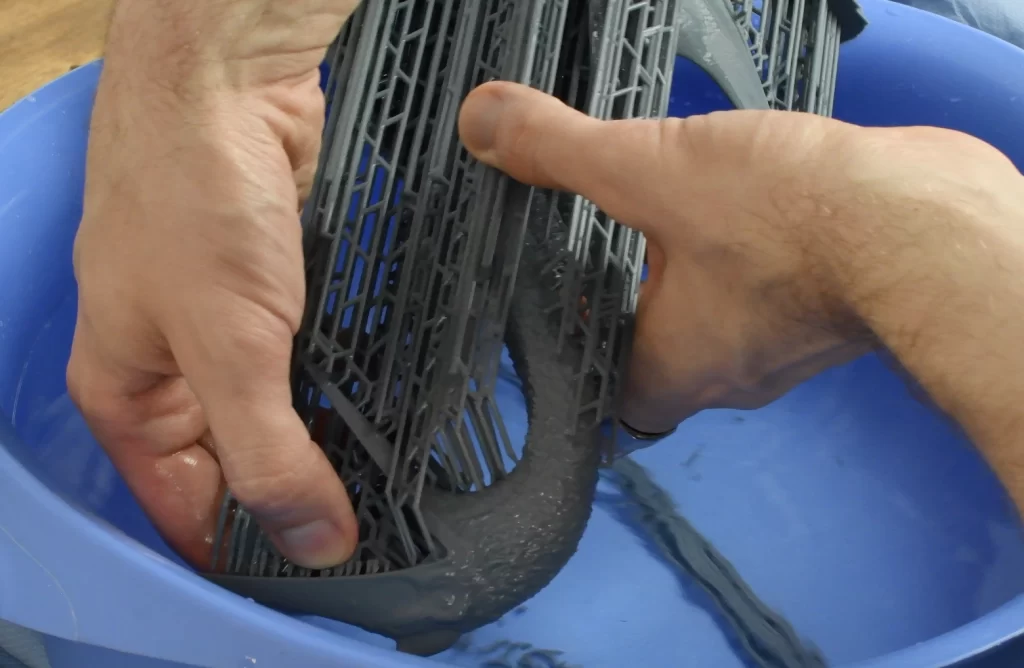- Wet Filament: Prevention, Symptoms & Drying - July 18, 2024
- Sovol SV08 – Best PrusaSlicer Settings & Profile - June 26, 2024
- Sovol SV08 – Best Orca Slicer Settings & Profile - June 26, 2024
Disclosure: Links marked with * are Affiliate Links. I earn from qualifying purchases if you decide to make a purchase through these links – at no additional cost for you!
In this hands-on review, I print a large and complex model with the Jupiter SE Resin 3D printer from Elegoo*. It is absolutely huge and still has a high accuracy, which makes it perfect for printing large, detailed objects in one piece.
Review Summary
Overall, the Jupiter SE Resin 3D printer from Elegoo impresses with its high precision, although it has a huge printing volume. In the past, these two features were not found simultaneously in a resin printer because the larger the LCD becomes, the lower the resolution gets (until now).
These are my highlights of the Jupiter SE:

Precision
High-precision thanks to 6K resolution and a powerful light source.

Resin Pump
Automatically gets triggered when resin is below threshold – perfect for big projects.

User-Friendliness
Easy leveling and control over printing and the pump via the touchscreen.

Huge Build Volume
You can print large objects in one piece with max. 278 × 156 × 300 mm.
OVERALL RATING:
4,7/5
PROS
✓ High Print Quality
✓ Fast Printing Speeds
✓ Easy Leveling
✓ Large Build Volume
✓ Resin Pump
CONS
× No Wi-Fi module
The Jupiter SE from Elegoo is a large-format resin 3D printer with a resin pump, surprising good print quality and a very affordable price-tag for this kind of machine.
It is perfect for printing large objects in one piece or a lot of small things at once (like a whole squad of wargaming miniatures!).
You can watch my full review here:
Table of Contents:
Preparing the STL

But first I need a suitable object. And what could be more suitable than something that is, or in this case was, simply huge in real life – a Quetzalcoatlus?

After a quick search, I found this 3D model. It is perfect and, apart from the outrageous tongue, looks quite realistic.

The Jupiter SE has a print volume of 278 × 156 × 300 mm and I want to use it completely with this print.
With a scaling of 200%, it has almost reached the maximum print height and all parts, including the base, still fit on the print bed.
As I plan to paint the finished model, I set the layer height to 0.02 mm in order to preserve all the details as well as possible. The Jupiter SE can also print layer heights of just 0.01 mm, but that would be overkill for this project and would only needlessly extend the printing time, which is already more than 37 hours!
And now we will prepare the Jupiter SE for printing!
Leveling the Jupiter SE

First, the print bed needs to be leveled. For leveling, the four screws on the print bed have to be loosened so that it can move freely.

In the Z0 position, I press the plate down onto the leveling paper with one hand and tighten the screws again. This ensures that the inclination of the print bed is automatically adjusted to the LCD screen and the distance between the LCD and the print bed is set to the thickness of the paper.
Resin Pump

The resin vat holds more than 1.7 liters of resin, which is more than enough for most projects. For projects that require even more resin, a pump is also included in the scope of delivery.

It automatically pumps more resin into the vat as soon as the resin level falls below a certain level.
But even if you are printing smaller projects, the pump is very practical as it can also pump the resin back into the bottle.
Calibrating the Jupiter SE

Before I print the Quetzalcoatlus, I calibrate the exposure time to adjust it to the resin I am using. Otherwise, small details become blurred when overexposed or are not properly defined when underexposed.
The standard setting of 1.5 seconds was a bit too long, a new attempt with 1.1 seconds produced better results. This means it’s finally time to start the big project!
Printing

The print ran absolutely flawlessly.
As the resin container has a much larger footprint than the LCD screen, small splashes of dripping resin are collected directly. With other resin 3D printers, this smears the hood and the printer itself very quickly and makes post-processing much more time-consuming. But even without the hood of the Jupiter SE, not a single drop was visible on the printer or the work surface after printing.

After printing, the first thing to do is to wash off the excess resin.

After that, the supports can be removed. Normally this is not a problem as long as the supports are correctly sized. However, I had scaled the pre-supported file by 200% and thus also the supports themselves. They became far too bulky and stable!
But I was able to soften the supports with warm water and remove them relatively easily.
And now the model just needs to be cured!

The result is already very impressive, but it only becomes epic after I’ve painted it!
Results



This flying reptile looks like a high-quality injection-molded model. Resin 3D printers have definitely revolutionized this hobby!



However, the Jupiter SE is not only suitable for large objects. You can also completely fill its print bed with a whole squad of miniatures and print them with perfect quality that can definitely keep up with store-bought miniatures! In my opinion, the quality is even better, as the typical injection-molded seam does not appear in 3D printing!
And with the proper antialiasing settings, you won’t see any layer steps, which are only visible with a magnifying glass anyway with the small layer heights.
My Verdict
I had no problems with the Jupiter SE from Elegoo during the test and had a lot of fun. The price is surprisingly low for such a large resin 3D printer, which is why I can definitely overlook minor issues such as the missing Wi-Fi module.
The Jupiter SE from Elegoo is a large-format resin 3D printer with a resin pump, surprising good print quality and a very affordable price-tag for this kind of machine.
It is perfect for printing large objects in one piece or a lot of small things at once (like a whole squad of wargaming miniatures!).
Disclosure: This website is the property of Martin Lütkemeyer and is operated by Martin Lütkemeyer. Martin Lütkemeyer is a member of the Amazon Services LLC and other Affiliate Programs. These are affiliate advertising programs designed to enable websites to earn advertising revenue through advertising and linking to Amazon.com and others. Links marked with * are affiliate links.


